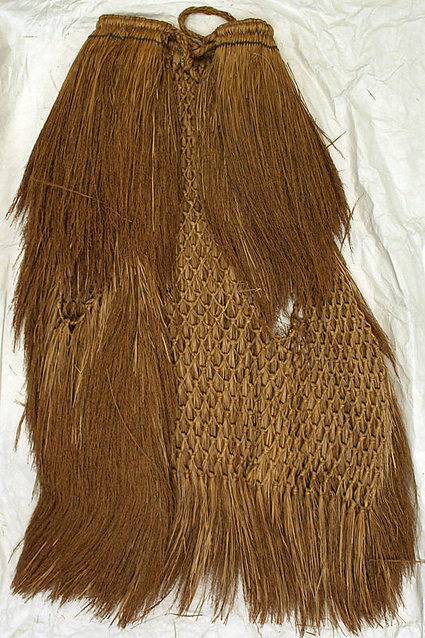My source of inspiration has it's origin in a Japanese Haiku by Basho. He wrote it in 1689-90, He was on his way home to his town Ise, through the mountains. Suddenly it started to snow:
first november snow
monkey too wishes for
small straw raincoat
S U B J E C T
As far as I know, people in Japan wore jackets or capes of grass till the previous century, for protection against rain and snow.Straw ia a sound insulation material and the grass blades lead water outward in droplets .This use is very ancient, it was already known by man in the western prehistoric times.Archaeological finds of Ötzi, the Icemummy, prove that these people were very well equipped to live in their natural environment.
W H A T
Brainwave 1 – mycelium is grown on straw for support and nourishment. What would happen if the “aliment”, a knotted mat made of straw or of fine grass, becomes immediately carrier of a new material?
Brainwave 2 – how can it be achieved that the mycelium will not grow more than a certain thickness, in a way that grass will still stick out on the outside.
H O W
I read in an article about the property's of chilli peppers, how they resist mold by being so hot. Could we do research with a substance like capsainoïden, and try to controll during the trial where mycelium is allowed to grow? If that works, it can be interesting to create structures and patterns. Initially it can lead us to a material in layers, inside a layer of limp and pliable insulation with water repellent mycelium or funghy, on the outside visible grass that is not overgrown by mycelium. Finally creating a "raincoat" with grass on the outside could be the ultimate challengeIn addition to the raincoat of straw, I would like to do research creating an Elves bench like structure that I have photographed. It looks very similar to Astracan in my opinion. It would be a fantastic goal to eliminate this traditional lammy that is produced in such a horrid way, by a new product.Could we create such a ripple too, resembling a 3D pattern left by water in hard sand, using "waaiertje" or Schizophyllum and have it grow that way? This could be the next topic to continue the research on how to create new 3D fabrics. Together with the scientists I would like to select the proper characteristics that are necessary for these idea's for new material: supple and strong on the inside, and water-repellent on the outside. Which type grass is the most suitable for knotting, on which grass thrives this fungus the best, etc.
M O T I V A T I O N
As a graphic designer, I have always been interested in structures,
and paper engineering. I like to call myself a spatial designer and developer of
concepts.
I consider it a special chance to be able to work on such a innovative project, outside my direct field of expertise. As a typographer I am used to distinguish details meticulously and register small differences in form.
I expect that the results will bring us several surprises and new findings. With the knowledge about this new material I could start designing objects that have not existed before or are a better version for known solutions.


